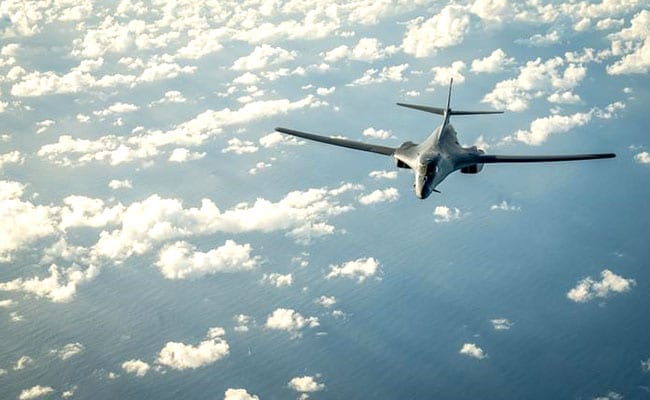
US bombers flew over the Korean Peninsula. (Reuters)
Washington:
US strategic bombers flew over the Korean Peninsula in a pointed show of force in response to Pyongyang's latest intercontinental ballistic missile, American officials said Saturday.
US B-1B bombers along with fighter jets from the South Korean and Japanese air forces participated in the 10-hour bilateral mission, practicing intercept and formation drills.
The maneuver followed Pyongyang's second ICBM test this month late Friday, with Kim Jong-Un saying the move demonstrated the country's ability to strike any target in the United States.
"North Korea remains the most urgent threat to regional stability," said General Terrence O'Shaughnessy, Pacific Air Forces commander, in a statement.
"If called upon, we are ready to respond with rapid, lethal, and overwhelming force at a time and place of our choosing."

The announcement coincided with another tweet storm from US President Donald Trump, who lambasted Beijing on the social media outlet for failing to rein in their North Korean allies.
"I am very disappointed in China. Our foolish past leaders have allowed them to make hundreds of billions of dollars a year in trade, yet they do NOTHING for us with North Korea, just talk," Trump wrote.
"We will no longer allow this to continue. China could easily solve this problem!"
Trump, who is at loggerheads with Beijing over how to handle Kim's regime, has repeatedly urged China to bridle its recalcitrant neighbor, but Beijing insists dialogue is the only practical way forward.
In a standard response to the test, Beijing urged restraint by all sides, after the US and South Korea conducted a live-fire exercise using surface-to-surface missiles.
Weapons experts said the altitude and flight time of Friday's missile suggested it was significantly more powerful than the earlier July 4 test, with a theoretical range of around 6,200 miles (10,000 kilometers) meaning it might be able to reach east coast US cities like New York, depending on the payload size.
South Korea said the test prompted it to speed up deployment of a US missile defense system, despite consistent protests from China that the program would destabilize the region.
(Except for the headline, this story has not been edited by NDTV staff and is published from a syndicated feed.)
US B-1B bombers along with fighter jets from the South Korean and Japanese air forces participated in the 10-hour bilateral mission, practicing intercept and formation drills.
The maneuver followed Pyongyang's second ICBM test this month late Friday, with Kim Jong-Un saying the move demonstrated the country's ability to strike any target in the United States.
"North Korea remains the most urgent threat to regional stability," said General Terrence O'Shaughnessy, Pacific Air Forces commander, in a statement.
"If called upon, we are ready to respond with rapid, lethal, and overwhelming force at a time and place of our choosing."

US Air Force B-1B Lancer bombers did a 10-hour mission from Andersen Air Force Base, Guam. (Reuters)
The announcement coincided with another tweet storm from US President Donald Trump, who lambasted Beijing on the social media outlet for failing to rein in their North Korean allies.
"I am very disappointed in China. Our foolish past leaders have allowed them to make hundreds of billions of dollars a year in trade, yet they do NOTHING for us with North Korea, just talk," Trump wrote.
"We will no longer allow this to continue. China could easily solve this problem!"
Trump, who is at loggerheads with Beijing over how to handle Kim's regime, has repeatedly urged China to bridle its recalcitrant neighbor, but Beijing insists dialogue is the only practical way forward.
In a standard response to the test, Beijing urged restraint by all sides, after the US and South Korea conducted a live-fire exercise using surface-to-surface missiles.
Weapons experts said the altitude and flight time of Friday's missile suggested it was significantly more powerful than the earlier July 4 test, with a theoretical range of around 6,200 miles (10,000 kilometers) meaning it might be able to reach east coast US cities like New York, depending on the payload size.
South Korea said the test prompted it to speed up deployment of a US missile defense system, despite consistent protests from China that the program would destabilize the region.
(Except for the headline, this story has not been edited by NDTV staff and is published from a syndicated feed.)
Track Latest News Live on NDTV.com and get news updates from India and around the world

